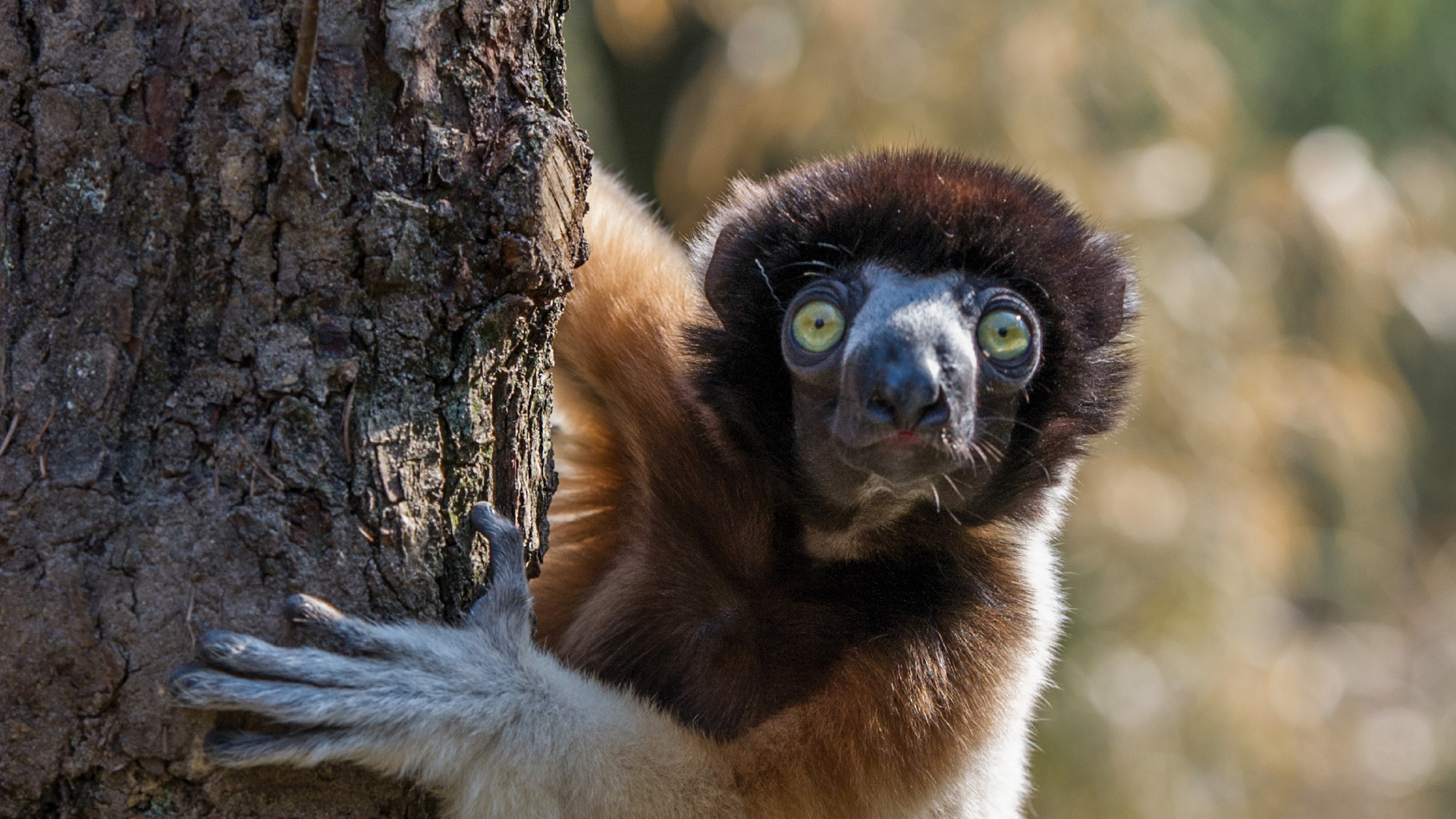Crowned Sifaka
Propithecus coronatus
Habitat
Tropical, dry deciduous forests
Food
Leaves, flowers and bark
Weight
± 3,5 kg
Age
18 to 22 years
IUCN Status
Ernstig bedreigd
Appearance
Crowned sifakas have woolly, white fur. They have black faces with a ‘black cap’ and brown shoulders. Their legs are quite a bit longer than their arms. This is very handy, as sifaka’s can easily make large jumps between trees. When they walk on the ground, these animals cannot easily walk on all fours. That’s why they move forward on jumping on just their feet! Crowned sifakas are a type of lemur. They have a stubby snout with a wet nose at the end. Crowned sifakas also have some useful characteristics that help them keep each other’s fur clean: the teeth in their lower jaw serves as a comb and they have a toe with a special nail used for brushing. This enables them to thoroughly clean their own fur. This is also a way for them to maintain social relationships.
Habitat
In the wild, crowned sifakas live on the island of Madagascar. There, they are mostly found in tropical, dry deciduous forests. Sometimes they venture into mangrove forests. Due to their ability to make enormous leaps, they can move extremely fast and they have no trouble jumping through prickly shrubbery. That’s because crowned sifakas have small, protective pads on their hands and feet.
Lifestyle
Crowned sifakas live in small groups. Groups consist on average of five individuals: one or more adult females, one or more adult males and their offspring. As is the case for many other lemurs, the females are in charge. For example, they are entitled to receive the tastiest food.
Behaviour
Crowned sifakas are usually relatively quiet, calm animals. But they do possess a very shrill and loud alarm call. They use this call, for example, if there is danger and they want to keep the group together. The call sounds a bit like ‘shi-fak’ which is where they get their name from. Besides sounds, crowned sifakas also use scents to communicate. They use their olfactory glands (on their anus, chest and throat) to deposit scents. These scents tell other animals about their age, sex and whether they want to mate. In addition, crowned sifakas are very good at jumping. They can leap huge distances, up to as much as ten metres! Crowned sifakas move about on the ground by means of graceful, bouncing leaps. They jump vertically, sometimes holding their arms above their head. When they do this, they look just like ballet dancers!

Reproduction
Crowned sifakas are only fertile for a very limited time, one and a half days per year at the most. During that time, females mate with multiple males. In the wild as well as at Apenheul, the mating season is in April. The mother gives birth after a gestation period of about 150 days. Initially, the mother carries her offspring around on her belly. Later on, the infant moves to her back. Crowned sifakas become independent by about six months. They become sexually mature at about two years of age. Females usually remain in their natal group their entire life. Males move from one group to another.
Situation in the wild
In the past, people worshipped crowned sifakas. That’s because crowned sifakas sunbathe every day. They then sit or lie with their arms spread out and their face directed towards the sun. This caused people to believe that crowned sifakas were sacred animals. These taboos have mostly disappeared. Now people hunt crowned sifakas for their meat. Their habitat is disappearing too: more and more of the rainforest in which they live is being cut down. Nowadays crowned sifakas are threatened with extinction.

At Apenheul
At Apenheul the crowned sifakas share an enclosure with the Lac Alaotra bamboo lemurs. They don’t roam freely among the visitors because crowned sifakas can jump up to ten metres. That means they could easily jump over the Apenheul perimeter fence. In 2005 the first crowned sifakas arrived at our zoo. And the very first crowned sifaka baby to be born in the Netherlands was born at Apenheul! That was in 2009. Holly, one of the female crowned sifakas, has a nipple disorder. This means she can’t feed her own offspring. The Apenheul zookeepers feed her infants by bottle, without interfering with the infant-parent relationships.
Population management programme
Apenheul is part of the European endangered species programme (EEP) crowned sifaka’s. By working together with other zoos we ensure a genetically healthy and demographically stable population of lemurs is maintained in zoos.
Apenheul Primate Conservation Trust
The Apenheul Primate Conservation Trust supports a nature conservation project in Madagascar to protect this species in the wild. Through this project we try to relocate the crowned lemurs to a habitat where they can live safely and well, and where they can also reproduce further.
Fun facts
Crowned sifakas hardly drink at all. They get most of the liquids they need from their diet, which consists mostly of leaves.
There are very few crowned sifakas in zoos. Only a few zoos in Europe keep them. And Apenheul is one of them!
Want to see the Crowned Sifakas at Apenheul?
Get your tickets now and spot all the primate species!

Welcome to Apenheul
Open for business events
Park open from Friday 20 March, 10.00 hour